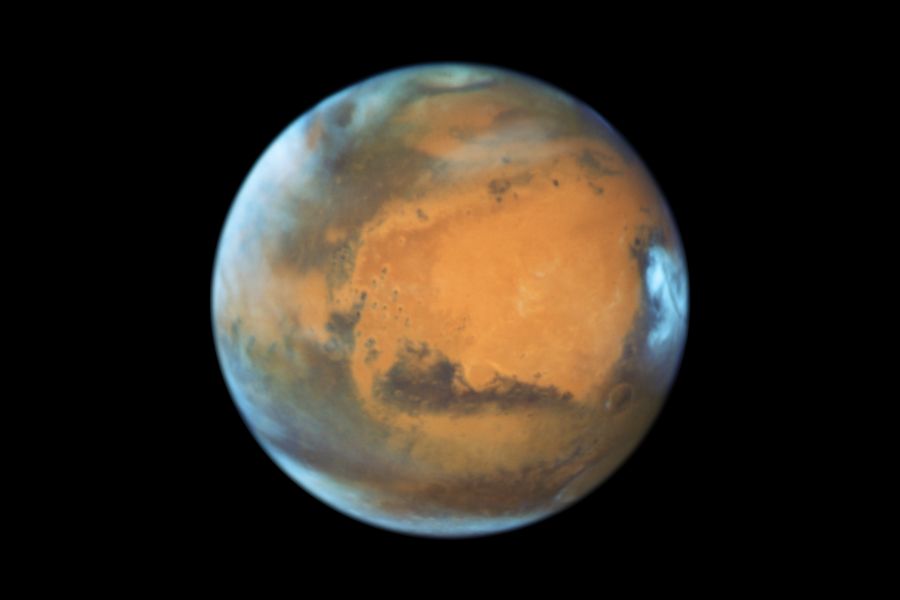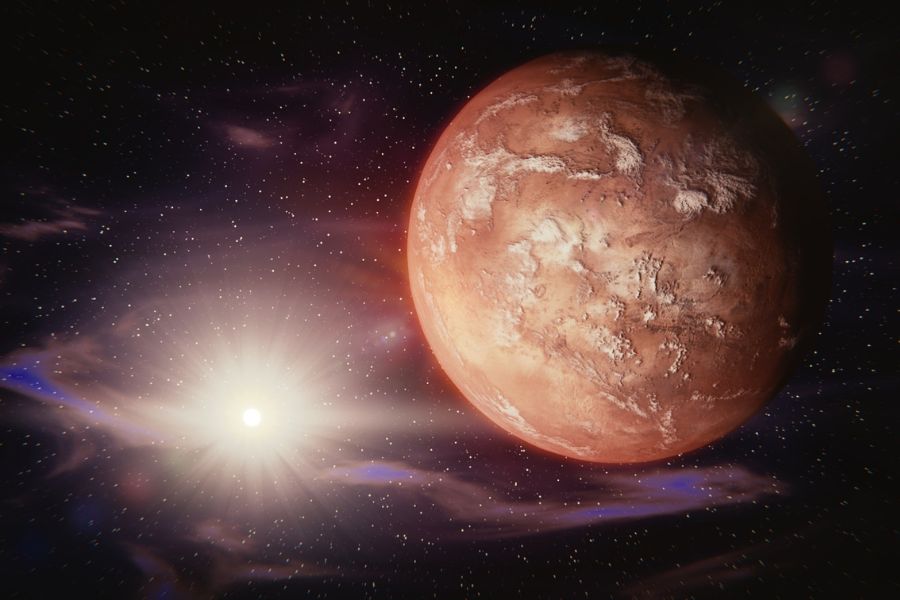Mars, the fourth planet from the Sun, is a terrestrial planet with some remarkable similarities and stark differences compared to Earth. It boasts a day that’s only a little longer than Earth’s, at approximately 24 hours and 39 minutes, giving us a sense of temporal familiarity. Yet, it’s anything but familiar.
While its barren and desolate landscape may seem inhospitable, its climate is a subject of fascination and exploration. In this journey, we’ll delve deep into the Mars climate, unraveling its mysteries and understanding the factors that make it one of the most intriguing planets in our solar system.
Join us as we venture into the intricacies of Martian weather patterns, the challenges of its thin atmosphere, and the tantalizing hints of a planet that may have once been more Earth-like than we ever imagined. Mars’ climate is a puzzle waiting to be solved, and we are ready to decode its every nuance.
Mars, The Red Planet Climate
So, what’s Mars’ climate like? Mars presents a harsh and challenging climate. Its thin atmosphere is primarily composed of carbon dioxide, offering little protection. The planet experiences extreme temperature variations, with an average of -80°F (-62°C).
One of the most striking features of Mars is its thin atmosphere, composed mainly of carbon dioxide (about 95%) with trace amounts of other gasses like nitrogen and argon. This thin atmosphere, about 1% as dense as Earth’s, plays a pivotal role in shaping Martian weather and climate.
Mars boasts longer and more pronounced seasons than Earth, thanks to its elongated orbit, and frequent dust storms can obscure its surface. Additionally, polar ice caps, consisting of both water and dry ice, add to the planet’s unique climate characteristics. These factors make Mars a formidable environment for human exploration.
As a terrestrial planet, Mars has a rich history of human fascination. It orbits the Sun at an average distance of approximately 225 million kilometers (140 million miles) and, like Earth, resides within the habitable zone, often referred to as the “Goldilocks zone”.
This zone represents the sweet spot in the solar system, where conditions may support the existence of liquid water – a key ingredient for life as we know it.

Understanding Martian Days and Seasons
Mars, with its distinctive climate and unique orbital characteristics, experiences days and seasons quite different from those on Earth. Exploring the Martian day, year, and seasons reveals the planet’s intriguing dynamics.
Comparison of Martian day to Earth day
On Mars, a day, often referred to as a “sol“, is only slightly longer than a day on Earth, lasting approximately 24 hours and 39 minutes. This similarity in day length is a welcome point of reference for human explorers, as it facilitates mission planning and scheduling.
However, despite the temporal familiarity, the Martian environment presents unique challenges. Its thin atmosphere and extreme temperatures make each sol a demanding experience, emphasizing the need for advanced life support systems and habitats.
The Martian year and its implications
A Martian year is significantly longer than an Earth year, lasting approximately 687 Earth days. This extended year results in longer and more pronounced seasons on the planet.
The varying distance between Mars and the Sun during its elliptical orbit plays a crucial role in driving these seasonal changes. These protracted seasons hold significant implications for climate patterns, weather, and potential future colonization efforts.
Understanding these seasonal dynamics is necessary for planning and surviving extended missions on Mars.
The role of axial tilt in Martian seasons
Like Earth, Mars has an axial tilt, which is responsible for the changing seasons on the planet. However, the degree of tilt and its impact on seasons differ. Mars has an axial tilt of approximately 25.2 degrees, somewhat close to Earth’s 23.5 degrees.
This tilt results in four distinct seasons on Mars: spring, summer, autumn, and winter. Due to the longer Martian year, each season is roughly twice as long as its Earth counterpart. These prolonged seasons, combined with the planet’s unique climate, give rise to weather patterns and phenomena that are unlike anything seen on Earth.
The Thin Atmosphere of Mars
Mars’ atmosphere, or lack thereof, is a defining feature of its climate, setting it apart from Earth in several critical ways.
Composition of the Martian atmosphere
Mars’ atmosphere is extraordinarily thin compared to Earth’s. It consists primarily of carbon dioxide, making up about 95% of the total atmospheric composition. Trace amounts of other gasses, such as nitrogen and argon, are also present.
This stark contrast with Earth’s rich and life-sustaining atmosphere presents a formidable challenge for human exploration and habitation.
Challenges posed by Mars’ thin atmosphere
The thin Martian atmosphere poses numerous challenges for future missions. Its lack of oxygen makes it inhospitable for humans, necessitating the use of spacesuits and life support systems to provide a stable supply of breathable air.
Additionally, the thin atmosphere provides minimum protection against harmful solar and cosmic radiation, posing health risks to astronauts. Addressing these challenges is crucial for ensuring the safety and success of missions to Mars.
Impact of the thin atmosphere on climate
Mars’ thin atmosphere significantly influences its climate. The limited heat-retaining capacity of the atmosphere results in rapid temperature fluctuations between day and night.
Furthermore, the lack of a substantial greenhouse effect, which Earth’s atmosphere provides, contributes to the planet’s overall cold and arid climate. Understanding these atmospheric dynamics is important for comprehending the broader climate patterns on Mars.
Extreme Temperature Variations
Mars is known for its extreme temperature variations, with conditions ranging from bitterly cold to relatively milder in specific regions.
Extreme Temperature Variations
Mars is known for its extreme temperature variations, with conditions ranging from bitterly cold to relatively milder in specific regions.
Average surface temperatures on Mars hover around a bone-chilling -80°F (-62°C). However, these temperatures can vary widely depending on the location and time of day.
In the polar regions during winter, temperatures can plummet to an astonishing -195°F (-125°C), while daytime temperatures in equatorial regions may briefly reach around 70°F (20°C). The planet’s thin atmosphere contributes to these rapid temperature fluctuations, with frigid nights and relatively milder daytime temperatures.
Factors contributing to extreme cold on the planet
The extreme cold on Mars can be attributed to its thin atmosphere, which lacks the insulating properties of Earth’s atmosphere. As a result, heat quickly escapes into space during the night, leading to the sharp temperature drop. The planet’s greater distance from the Sun compared to Earth also contributes to its overall cold climate.
Occasional milder temperatures in specific regions
Despite its predominantly harsh climate, there are regions on Mars where temperatures can be relatively milder. These areas, often situated near the equator, experience occasional daytime temperatures that hover around or slightly above freezing.
Frequent Dust Storms
Mars is notorious for its frequent and sometimes massive dust storms, which can have a significant impact on its climate and weather.
Understanding Martian dust storms
Martian dust storms are awe-inspiring phenomena that can engulf the entire planet in a shroud of reddish haze. These storms differ from those on Earth due to the planet’s unique conditions.
They are primarily driven by high-speed winds that kick up fine dust particles from the Martian surface. The dust, once airborne, scatters sunlight and heats the atmosphere, creating a positive feedback loop that sustains the storm’s intensity.
Causes and effects of dust storms on Mars
There are two types of dust storms that happen frequently on Mars:
- Local dust storms
- Global dust storms
Local storms are smaller, localized dust storms on Mars that are relatively common and typically pose few threats. They can be caused by local temperature fluctuations, surface features, or the planet’s complex wind patterns.
On the other hand, Mars experiences occasional global dust storms as well, which can last for weeks or even months. These storms often begin as smaller disturbances and can rapidly escalate into planet-covering tempests.
Global dust storms have significant consequences, including reduced sunlight reaching the surface, altered temperature patterns, and challenges for solar-powered rovers and landers.
Influence of dust storms on climate patterns
Dust storms play a vital role in shaping Mars’ climate patterns. They affect the planet’s albedo, or reflectivity, by darkening its surface as dust settles. This change in albedo impacts the planet’s heat absorption and radiation balance.
Dust storms can also contribute to shifts in temperature and pressure patterns, influencing wind circulation and weather systems. Understanding the complex interplay between dust storms and Martian climate is essential for predicting and mitigating their effects on future missions.

Polar Ice Caps and Water on Mars
Mars, despite its arid and seemingly desolate appearance, harbors significant reservoirs of water ice in its polar regions.
Existence of polar ice caps on Mars
Mars boasts polar ice caps at both its northern and southern extremities. These ice caps are composed of a mixture of water ice and dry ice or frozen carbon dioxide.
The polar caps undergo seasonal variations, expanding and contracting as Mars orbits the Sun. These variations are vital for understanding the planet’s climate and its history of water.
Composition of polar ice caps
- Water ice – The polar ice caps primarily consist of water ice, which is a valuable resource for potential future human missions. Water ice can be used for drinking water, agriculture, and fuel production.
- Dry ice – Dry ice, or frozen carbon dioxide, is also present, particularly in the southern polar cap. This dry ice undergoes sublimation, transitioning directly from a solid to a gas, during the Martian summer, which can influence atmospheric pressure and climate.
Implications of polar ice caps for Martian climate
The polar ice caps play a crucial role in regulating the Martian climate. They are central to the planet’s water cycle, influencing humidity, atmospheric dynamics, and weather patterns.
Additionally, changes in the polar ice caps, such as seasonal expansion and contraction, have implications for Martian climate variability and long-term climate trends. Acknowledging these ice caps is pivotal for deciphering the history of water on Mars and its potential for supporting future human exploration and colonization efforts.
Frequently Asked Questions
What are the primary greenhouse gases in Mars’s atmosphere?
Mars’s thin atmosphere primarily consists of carbon dioxide (CO2), making up about 95% of the gas present. While it’s the dominant component, its density is still significantly lower than Earth’s atmosphere.
Other trace gasses, including nitrogen (N2) and argon (Ar), are present in smaller amounts. The scarcity of greenhouse gasses like methane (CH4) and water vapor (H2O) contributes to the planet’s limited greenhouse effect, which is far less substantial than on Earth.
Does it rain on Mars?
Mars experiences precipitation, but it differs significantly from Earth. Instead of liquid water rain, Mars can have snowfall and frost. The planet’s thin atmosphere and low temperatures prevent liquid water from forming on the surface.
When it does snow, it typically involves water ice or frozen carbon dioxide (dry ice). Snowfall is more common at higher latitudes and elevations, especially during the colder Martian winters.
Is it ever sunny on Mars?
Yes, Mars does have sunny days, but the quality of sunlight is different from Earth due to its thinner atmosphere and the presence of airborne dust. The sun on Mars appears about half the size as it does from Earth’s perspective.
Additionally, the thin atmosphere scatters sunlight, creating a reddish hue and reducing the intensity of direct sunlight. Despite these differences, sunny days on Mars can still be quite bright, and the planet receives a significant amount of solar energy, which is vital for powering solar panels used on spacecraft and future Martian colonies.
How does Mars’ climate affect potential human missions?
Mars’ harsh climate, characterized by extreme cold, dust storms, and low air pressure, poses significant challenges for human missions. It necessitates advanced life support systems, temperature regulation, radiation protection, and careful planning for dust storm contingencies.
Understanding the Martian climate is crucial for designing habitats, spacesuits, and technologies that can withstand and adapt to the planet’s unique environmental conditions.
Conclusions
Our journey through the intricacies of Mars’ climate has unveiled a wealth of defining features that set it apart as a unique and captivating planetary environment.
We’ve delved into the specifics of this enigmatic Mars climate, from its thin atmosphere to extreme temperature variations, frequent dust storms, and the presence of polar ice caps.
These insights underscore the significance of studying Mars’ climate, not just for scientific understanding but also for the potential future of human exploration.
As we contemplate the mysteries of Mars’ climate, we find ourselves on the threshold of a new era in space exploration. The lessons we’ve learned from this neighboring world will undoubtedly shape our understanding of other celestial bodies and guide our path toward the stars.
Mars’ climate stands as a testament to the extraordinary mysteries of the cosmos, a captivating reminder of the limitless potential that lies beyond our terrestrial confines.
As we continue to uncover the secrets of the Red Planet, we not only deepen our understanding of our planetary neighbor but also advance our journey towards the stars, where a universe of endless discoveries awaits.

